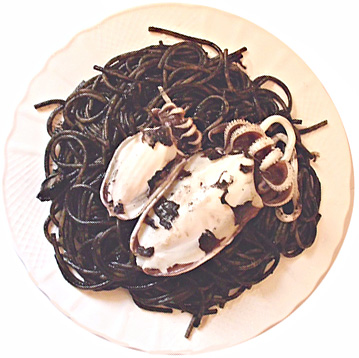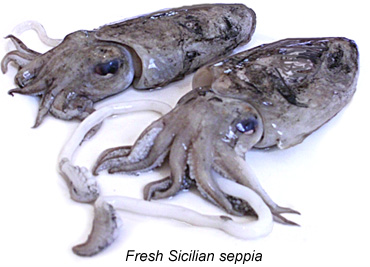...Best of Sicily presents... Best of Sicily Magazine. ... Dedicated to Sicilian art, culture, history, people, places and all things Sicilian. |
by Roberta Gangi | ||
Magazine Index Best of Sicily Arts & Culture Fashion Food & Wine History & Society About Us Travel Faqs Contact Map of Sicily |
Cuttlefish prosper in certain regions, such as the Mediterranean, while avoiding others like the northern Atlantic. They prefer warmer waters. To most of us, this squid-like creature is best known for its boney internal shell, the cuttlebone. Rich in calcium and chalky in texture when dry, the cuttlebone is placed in the cages of birds like parrots so that our winged friends can grind their beaks on it. For those of us without feathers, there are two edible parts of the seppia - the flesh which tastes like octopus or squid, and the dark ink. The ink, incidentally, is the natural coloring used in making black pasta, and it's more viscous than squid ink. Tastier, too, according to connoisseurs.
By definition, cuttlefish belong to the order sepiida and are distantly related to squids, but the largest cuttlefish do not reach the dimensions of their cousins. The cuttlebone provides buoyancy to the creature, which can alter its color somewhat (a few octopi can do this) and has exceptionally good vision. Despite is black color, seppia sauce, or nero di seppia, is only part ink. It also contains seppia chunks, olive oil, sautéed garlic or onions, tomato puree (or paste), white wine, parsley and pepper. The ink is easily extracted from the glands of the cooked cuttlefish. The sauce is best with long pasta like that shown here. Remember that in Italy seafood is never accompanied by grated cheese. About the Author: Roberta Gangi has written numerous articles and one book dealing with Italian cultural and culinary history, and a number of food and wine articles for Best of Sicily Magazine. | |
Top of Page |
 There must
be an entire category of "exotic" foods, made from unusual plants
and animals, that most people have never heard of. Well, there's Andrew
Zimmern's show (Bizarre Foods), and Andrew did come to Sicily a few years
ago, but there are a few things you might overlook if we didn't point them
out. One of them is seppia, or cuttlefish.
There must
be an entire category of "exotic" foods, made from unusual plants
and animals, that most people have never heard of. Well, there's Andrew
Zimmern's show (Bizarre Foods), and Andrew did come to Sicily a few years
ago, but there are a few things you might overlook if we didn't point them
out. One of them is seppia, or cuttlefish. Seppia ink is also a main
ingredient of a popular pasta sauce but first we should mention its historical
use in the actual ink used for writing. The word sepia refers to a dark
brown color associated with old photographs. In fact, the term is rooted
in references to the faded tone of writing inks made from cuttlefish ink,
which is much more viscous than squid ink and remains distinct for centuries.
Seppia ink is also a main
ingredient of a popular pasta sauce but first we should mention its historical
use in the actual ink used for writing. The word sepia refers to a dark
brown color associated with old photographs. In fact, the term is rooted
in references to the faded tone of writing inks made from cuttlefish ink,
which is much more viscous than squid ink and remains distinct for centuries.